Fauna of Australia
| Part of a series on |
| Wildlife of Australia |
|---|
 |
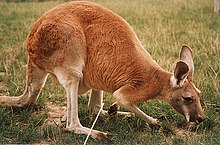
The fauna of Australia consists of a large variety of animals; some 46% of birds, 69% of mammals, 94% of amphibians, and 93% of reptiles that inhabit
.The settlement of Australia by
Origins and history

Both geologic and climatic events helped to make Australia's fauna unique.[5] Australia was once part of the southern supercontinent Gondwana,[6] which also included South America, Africa, India and Antarctica. Gondwana began to break up 140 million years ago (MYA); 50 MYA Australia separated from Antarctica and was relatively isolated until the collision of the Indo-Australian Plate with Asia in the Miocene era 5.3 MYA. The establishment and evolution of the present-day fauna was apparently shaped by the unique climate and the geology of the continent. As Australia drifted, it was, to some extent, isolated from the effects of global climate change. The unique fauna that originated in Gondwana, such as the marsupials, survived and adapted in Australia.[7]
After the Miocene, fauna of Asian origin were able to establish themselves in Australia. The Wallace Line — the hypothetical line separating the zoogeographical regions of Asia and Australasia — marks the tectonic boundary between the Eurasian and Indo-Australian plates. This continental boundary prevented the formation of land bridges and resulted in a distinct zoological distribution, with limited overlap, of most Asian and Australian fauna, with the exception of birds. Following the emergence of the circumpolar current in the mid-Oligocene era (some 15 MYA), the Australian climate became increasingly arid, giving rise to a diverse group of arid-specialised organisms, just as the wet tropical and seasonally wet areas gave rise to their own uniquely adapted species.[citation needed]
Mammals
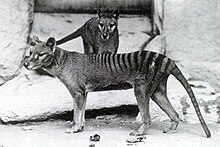
Australia has a rich mammalian fossil history, as well as a variety of extant mammalian species, dominated by the marsupials, currently however there is limited taxonomic research into Australia's mammals.
Monotremes and marsupials
Two of the five living species of monotreme occur in Australia: the platypus and the short-beaked echidna,[17] the other three being echidnas that only occur in New Guinea. Monotremes differ from other mammals in their methods of reproduction; in particular, they lay eggs instead of giving birth to live young.[17] The platypus — a venomous, egg-laying, duck-billed amphibious mammal — is considered to be one of the strangest creatures in the animal kingdom. When it was first presented by Joseph Banks to English naturalists it was thought to be a hoax.[17][18] The short-beaked echidna is covered in hairy spikes with a tubular snout in the place of a mouth, and a tongue that can move in and out of the snout at a rate of 100 times a minute to capture termites.[18][19]
Australia has the world's largest and most diverse range of
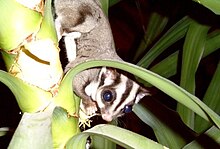
The

Marsupials with two front teeth (diprotodont) on the lower jaw and
The
The macropods are divided into three families: the
Placental mammals

Australia has indigenous placental mammals from two orders: the bats — order Chiroptera — represented by six families; and the mice and rats — order Rodentia, family Muridae. There are only two endemic genera of bats,[49] although 7% of the world's bat species live in Australia.[50] Rodents first arrived in Australia 5–10 MYA,[49] undergoing a wide radiation to produce the species collectively known as the "old endemic" rodents.[51] The old endemics are represented by 14 extant genera.[citation needed] A million years ago, the rat entered Australia from New Guinea and evolved into seven species of Rattus, collectively called the "new endemics".[51]
Since human settlement many additional

Forty-six marine mammals from the order
Birds

Australia and its territories are home to around 800 species of bird;
Relatively recent colonists from
About 200 species of
Amphibians and reptiles
Australia has four families of native frogs and one introduced

Australia has two species of
The Australian coast is visited by six species of
Australia is the only continent[
There are more species of snake in Darwin than any other Australian state capital, with 34 non-marine snake species found in the region, of which 23 have been recorded by professional snake catchers in Darwin itself.[119] Fortunately for the citizens of Darwin, a far smaller proportion of these snakes are highly venomous than is typically found in other cities, due to the low numbers of front-fanged elapid species and dominance of relatively harmless pythons and colubrid species.[120][121]
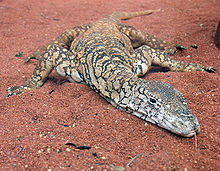
There are more than 700 species of lizards in Australia
Fish

More than 5000 species of fish inhabit Australia's waterways;
Several exotic freshwater fish species, including
Most of Australia's fish species are marine, and 75% live in tropical marine environments.
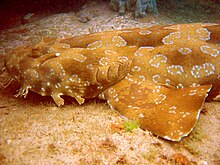
Invertebrates
| Taxonomic group | Estimated number of species described | Estimated total number of species in Australia |
|---|---|---|
Porifera
|
1,476 | ~3,500 |
| Cnidaria | 1,705 | ~2,200 |
Platyhelminthes
|
1,593 | ~10,000 |
| Acanthocephala | 56 | ~160 |
Nematoda
|
~2,060 | ~30,000 |
| Mollusca | ~8,700 | ~12,250 |
Annelida
|
2,192 | ~4,230 |
| Onychophora | 71 | ~80 |
Crustacea
|
7,266 | ~9,500 |
Arachnida
|
6,615 | ~31,338 |
Insecta
|
~62,000 | ~205,000 |
Echinodermata
|
1,475 | ~2,000 |
| Other invertebrates | ~2,371 | ~5,015 |
| Modified from: Williams et al. 2001[158] and Chapman, 2009[159] | ||
Of the estimated 200,000 animal species in Australia, about 96% are invertebrates. While the full extent of invertebrate diversity is uncertain, 90% of

Australia has a wide variety of
In the

The large family

A huge variety of marine invertebrates are found in Australian waters, with the
There are many unique marine crustaceans in Australian waters. The best-known class, to which all the edible species of crustacean belong, is
Invasive species

Introduction of exotic fauna in Australia by design, accident and natural processes has led to a considerable number of
Costly, laborious and time-consuming efforts at control of these species has met with little success and this continues to be a major problem area in the conservation of Australia's biodiversity.[197]
Many of the introduced species are not regulated through wildlife services and can be regularly hunted year round.[citation needed] Some states even fund hunting initiatives though the efficacy of these programs are disputed.[198]
According to a 2023 report co-authored by biologist Tim Low, invasive species are the leading cause of native Australian animal extinctions since the 1960s.[199]
Human impact and conservation
For at least 40,000 years, Australia's fauna played an integral role in the traditional lifestyles of Indigenous Australians, who relied upon many species as a source of food and skins. Vertebrates commonly harvested included macropods, possums, seals, fish and the short-tailed shearwater, most commonly known as the muttonbird. Invertebrates used as food included insects such as the bogong moth and larvae collectively called witchetty grubs and molluscs. The use of fire-stick farming, in which large swathes of bushland were burnt to facilitate hunting, modified both flora and fauna – and are thought to have contributed to the extinction of large herbivores with a specialised diet, such as the flightless birds from the genus Genyornis.[200] The role of hunting and landscape modification by aboriginal people in the extinction of the Australian megafauna is debated,[201] but increasingly favours the idea humans were responsible for megafaunal extinction.[202]
Despite the major impact of Aboriginals on native species populations, this is considered to be less significant than that of the European settlers,[201] whose impact on the landscape has been on a relatively large scale. Since European settlement, direct exploitation of native fauna, habitat destruction and the introduction of exotic predators and competitive herbivores has led to the extinction of some 27 mammal, 23 bird and 4 frog species. Much of Australia's fauna is protected by legislation.[1] The federal Environment Protection and Biodiversity Conservation Act 1999 was created to meet Australia's obligations as a signatory to the 1992 Convention on Biological Diversity. This act protects all native fauna and provides for the identification and protection of threatened species. In each state and territory, there is statutory listing of threatened species. At present, 380 animal species are classified as either endangered or threatened under the EPBC Act, and other species are protected under state and territory legislation.[203] More broadly, a complete cataloguing of all the species within Australia has been undertaken, a key step in the conservation of Australian fauna and biodiversity. In 1973, the federal government established the Australian Biological Resources Study (ABRS), which coordinates research in the taxonomy, identification, classification and distribution of flora and fauna. The ABRS maintains free online databases cataloguing much of the described Australian flora and fauna. Impacts such as the illegal setting of traps in rivers affect animals such as the Australian platypus, along with lack of awareness each year an average of 2–5 Australians lose their lives to what is presumed a safe creature. The key is understanding of Australia's diverse wildlife and fauna; what seems safe is often deadly.
The Australian Wildlife Conservancy is the largest private owner of land for conservation in the country which is dedicated to protecting endangered species across 4.8 million hectares of land in the most popular regions such as the Kimberley, Cape York, Lake Eyre and the Top End. This not-for-profit organisation is working hard to avoid extinction of the endangered native species in various wildlife sanctuaries.[204]
Australia is a member of the
The State of the Environment Report, 2001, prepared by independent researchers for the federal government, concluded that the condition of the environment and environmental management in Australia had worsened since the previous report in 1996. Of particular relevance to wildlife conservation, the report indicated that many processes — such as salinity, changing hydrological conditions, land clearing, fragmentation of ecosystems, poor management of the coastal environment, and invasive species — pose major problems for protecting Australia's biodiversity.[209]
See also
- List of mammals of Australia
- List of Australian monotremes and marsupials
- List of Australian bats
- List of Australian rodents
- List of placental mammals introduced to Australia
- List of Australian marine mammals
- List of Australian birds
- List of Australian, New Zealand and Antarctic birds
- List of birds of Tasmania
- List of ants of Australia
- List of butterflies of Australia
- List of moths of Australia
- List of Australian stick insects and mantids
- List of Dermapterans of Australia
- List of common Australian spiders
- List of extinct animals of Australia
- List of introduced fish in Australia
- Threatened fauna of Australia
- List of Australian animals extinct in the Holocene
- List of marine animals of Australia (temperate waters)
- Environmental issues in Australia
Notes
- ^ a b c Egerton, p. 44.
- ^ a b c d Cresswell, Ian; Murphy, Helen T. (2017). State of the Environment 2016: Biodiversity (PDF) (Report). Commonwealth of Australia Department of the Environment and Energy. Archived from the original (PDF) on 26 August 2021. Retrieved 26 August 2021.
- ISBN 1-876622-50-4
- PMID 21940856.
- ^ Egerton, pp. 14, 20.
- ^ Egerton, p. 20.
- ISBN 978-0-8018-8211-1.
- ^ a b c Egerton, p. 77.
- ISBN 9780643108738. Archivedfrom the original on 7 June 2014.
- ^ Egerton, p. 34.
- S2CID 4342084.
- S2CID 4338242.
- ISBN 978-1-4051-5658-5
- .
- ^ "Ringtail and Greater Gliding Possums (Pseudocheiridae) | Encyclopedia.com". www.encyclopedia.com. Retrieved 10 February 2020.
- ^ Egerton, p. 78.
- ^ a b c Egerton, p. 36.
- ^ a b Menkhorst and Knight, p. 44.
- ^ Egerton, p. 37.
- ^ Egerton, pp. 70–76.
- ^ a b Menkhorst and Knight, p. 48.
- ^ a b Egerton, p. 39.
- doi:10.1644/881.1.
- ^ a b Menkhorst and Knight, p. 46.
- ^ a b Egerton, p. 69.
- ^ "In Situ Work". Conjour. Archived from the original on 5 September 2018.
- ^ Smith, Ainslie Drewitt (29 October 2020). "Newborn eastern quoll joeys to be tracked with tail transmitters". ABC News Illawarra. Retrieved 26 August 2021.
- ^ Egerton, p. 68.
- ISBN 978-0-87196-871-5.
- ^ Egerton, p. 57.
- ^ Menkhorst and Knight, p. 52.
- ^ Egerton, pp. 78–79.
- ^ a b Menkhorst and Knight, pp. 80–84.
- ^ "Types of Bandicoots". Archived from the original on 17 March 2011. Retrieved 7 January 2012.
- ^ a b c Menkhorst and Knight, p. 86.
- ^ Menkhorst and Knight, p. 92.
- ^ Egerton, p. 60.
- ^ Menkhorst and Knight, p. 90.
- ^ Egerton, pp. 64–65.
- ^ Menkhorst and Knight, p. 94.
- ^ Egerton, p. 55.
- ^ Menkhorst and Knight, pp. 17–18.
- ^ Menkhorst and Knight, pp. 17, 104–110.
- ^ Menkhorst and Knight, pp. 17–18, 110–120.
- ^ Egerton, p. 42.
- ^ Menkhorst and Knight, p. 110.
- ^ Menkhorst and Knight, p. 120.
- ^ Menkhorst and Knight, p. 200.
- ^ a b c d e f g Egerton, p. 82.
- ^ Australia Inc., Wildcare. "Bats - Wildcare Australia". Wildcare Australia Inc.
- ^ a b Egerton, p. 93.
- PMID 15299143.
- ^ Egerton, pp. 105–107.
- ^ Egerton, pp. 106–110.
- ^ Menkhorst and Knight, pp. 208–220.
- ^ a b Egerton, p. 102.
- ^ a b c d Menkhorst and Knight, p. 254.
- ^ Menkhorst and Knight, pp. 22, 240.
- ^ AAP (5 July 2005). "New species of Reef dolphin discovered". The Age. Archived from the original on 7 December 2013. Retrieved 7 January 2012.
- ^ Menkhorst and Knight, pp. 224–234.
- ^ Lawler et al. 2002. Dugongs in the Great Barrier Reef: Current State of Knowledge Archived 21 February 2014 at the Wayback Machine. Cooperative Research Centre (CRC) for The Great Barrier Reef World Heritage Area.
- ^ Egerton, p. 122.
- ISBN 9780642568618. Archived(PDF) from the original on 18 September 2017.
- ^ Australian Museum. 2001. Fossil history of birds: fossil history overview Retrieved from Internet Archive 16 December 2013.
- ^ Egerton, pp. 124–125.
- ^ Egerton, pp. 126–127.
- ^ Egerton, p. 193.
- ^ Egerton, pp. 192–206.
- ^ Egerton, p. 221.
- ^ Sundar, K. S. Gopi; Grant, John D.; Inka, Veltheim; Kittur, Swati; Brandis, Kate; Michael, McCarthy; Scambler, Elinor (2018). "Sympatric cranes in northern Australia: abundance, breeding success, habitat preference and diet". Emu - Austral Ornithology. 119 (1): 79–89.
- ^ Egerton, p. 224.
- ^ Egerton, pp. 229–236.
- ^ Egerton, pp. 248–250.
- ^ Egerton, pp. 265–268.
- ^ Egerton, p. 237.
- ^ Egerton, pp. 233–234.
- ^ Egerton, pp. 238–246.
- ^ Egerton, p. 228.
- ^ Egerton, pp. 226–227.
- ^ Egerton, pp. 268, 272.
- ^ Egerton, p. 273.
- ^ Egerton, p. 275.
- ^ Egerton, pp. 290–291.
- ^ Egerton, p. 282.
- ^ Lewis, Nell; Lee, Woojin; Dotto, Carlotta. "The planet's most threatened flight path, and the $3 billion plan to protect it". www.cnn.com. Retrieved 22 March 2024.
- ^ "Wetlands and migratory shorebirds". Australian Government Department of Climate Change, Energy, the Environment and Water. 2016.
- ^ Egerton, pp. 146–147.
- ^ Egerton, p. 136.
- ^ Egerton, pp. 370–371.
- ^ Egerton, pp. 366, 379, 388–389.
- ^ Egerton, p. 389.
- ^ Invasive Species Specialist Group (1 June 2006). "Ecology of Bufo marinus". Global Invasive Species Database. Archived from the original on 17 August 2009. Retrieved 2 July 2009.
- ^ Egerton, p. 366.
- ^ Littlejohn, Murray J.; Roberts, J. Dale; Watson, Graham F.; Davies, Margaret (1993). "7. Family Myobatrachidae" (PDF). Fauna of Australia series, Environment Australia website. Canberra: Department of the Environment, Water, Heritage and the Arts, Australian Government. Archived from the original (PDF) on 20 March 2011. Retrieved 19 August 2010.
- ^ Egerton, p. 377.
- ^ Egerton, p. 379.
- ^ Egerton, pp. 379–387.
- ^ Burton, Thomas C. (1993). "9. Family Microhylidae" (PDF). Fauna of Australia series, Environment Australia website. Canberra: Department of the Environment, Water, Heritage and the Arts, Australian Government. Archived from the original (PDF) on 20 March 2011. Retrieved 19 August 2010.
- ^ Egerton, p. 388.
- ^ a b Egerton, p. 385.
- ^ Young, Emma (21 July 2010). "Australian species are older, study says". Australian Geographic. Archived from the original on 25 July 2010. Retrieved 5 August 2010.
- ^ a b Egerton, p. 299.
- ^ Egerton, pp. 298–299.
- ^ "Crocodilian Species – Australian Saltwater Crocodile (Crocodylus porosus)". Flmnh.ufl.edu. Archived from the original on 17 July 2011. Retrieved 24 July 2011.
- ^ "Saltwater Crocodile". Australianfauna.com. Archived from the original on 25 July 2011. Retrieved 24 July 2011.
- ISBN 978-0-85112-235-9
- ^ a b Egerton, p. 298.
- ^ Egerton, pp. 300–302.
- ^ "Marine Turtles". Environment.gov.au. 27 August 2007. Archived from the original on 23 August 2011. Retrieved 24 July 2011.
- ^ Turtle Taxonomy Working Group [van Dijk PP, Iverson JB, Rhodin AGJ, Shaffer HB, Bour R]. 2014. Turtles of the World, 7th edition: annotated checklist of taxonomy, synonymy, distribution with maps, and conservation status. In: Rhodin AGJ, Pritchard PCH, van Dijk PP, Saumure RA, Buhlmann KA, Iverson JB, Mittermeier RA (Editors). Conservation Biology of Freshwater Turtles and Tortoises: A Compilation Project of the IUCN/SSC Tortoise and Freshwater Turtle Specialist Group. Chelonian Research Monographs 5 (7): 000.329–479 Archived 2 May 2015 at Wikiwix, doi:10.3854/ crm.5.000.checklist.v7.2014.
- ^ Egerton, p. 305.
- ^ Legler, John M. (1993). "15. General Description and Definition of the Order Chelonia" (PDF). Fauna of Australia series, Environment Australia website. Canberra: Department of the Environment, Water, Heritage and the Arts, Australian Government. Archived from the original (PDF) on 20 March 2011. Retrieved 19 August 2010.
- ^ Egerton, p. 341.
- ^ Egerton, p. 352.
- ^ Egerton, p. 351.
- ^ Egerton, pp. 352, 356.
- ^ Wilson and Swan (2017), p. 526
- ^ Wilson and Swan (2017), p. 476
- ISSN 1442-9985.
- ISSN 1573-1642.
- ISSN 1572-9710.
- ^ Wilson and Swan (2017), p. 458.
- ^ a b c d e f "The Reptile Database". The Reptile Database. Archived from the original on 2 November 2015. Retrieved 24 July 2011.
- ^ Egerton, p. 306.
- ^ Egerton, p. 315.
- ^ Egerton, pp. 319, 323.
- ^ Egerton, p. 324.
- ^ Egerton, p. 327.
- ^ Egerton, p. 339.
- ^ Bray, Dianne; Thompson, Vanessa. "Murray Cod, Maccullochella peelii". Fishes of Australia. Archived from the original on 9 October 2014. Retrieved 6 October 2014.
- ^ a b c Bray, Dianne. "Introduction to Australia's Fishes". Fishes of Australia. Archived from the original on 22 August 2014. Retrieved 6 October 2014.
- ^ OCLC 49901785.
- ^ Egerton, p. 409.
- S2CID 22778872.
- S2CID 21584756.
- ^ Williams, W.D. and Allen, G.R. 1987. Origins and adaptations of the fauna of inland waters. In D.W. Walton Ed. Fauna of Australia, Volume 1A. Australian Government Publishing Service, Canberra.
- ^ Egerton, p. 395.
- ^ Prokop, pp. 12, 36.
- ^ Egerton, p. 440.
- ^ Prokop, pp. 10, 18.
- ^ a b Egerton, p. 434.
- ISBN 0-642-16818-0
- ^ Egerton, pp. 413, 420.
- ^ Egerton, pp. 433–434.
- . Retrieved 12 November 2021.
- ^ Egerton, pp. 449, 451.
- ^ Egerton, pp. 459–463.
- ^ Egerton, pp. 446, 467–468, 478.
- ^ Egerton, pp. 480, 486.
- ^ Egerton, pp. 435. 489–490.
- ^ Egerton, p. 406.
- ^ Egerton, p. 481.
- ^ Kuiter, p. 12.
- ^ Kuiter, p. 8.
- ^ International Shark Attack File. 2005. SAF Statistics for the Worldwide Locations with the Highest Shark Attack Activity Since 1990 Archived 17 February 2011 at Wikiwix, Florida Museum of Natural History
- ^ Egerton, p. 397.
- ^ ISBN 0-643-06749-3
- ^ Chapman, Arthur D. (September 2009). Numbers of Living Species in Australia and the World (PDF) (Report) (2nd ed.). Australian Biological Resources Study. Retrieved 27 August 2021.
- ^ Egerton, p. 492.
- ^ Egerton, pp. 494–495, 520, 553.
- ^ Egerton, pp. 538–540.
- ^ Egerton, p. 545.
- ^ CSIRO Entomology: Insects and their allies Insects and their allies Archived 15 June 2005 at the Wayback Machine
- ^ Egerton, pp. 542–543.
- ^ Egerton, pp. 533–535.
- ^ Egerton, pp. 528–531.
- ^ Egerton, p. 552.
- ^ "red imported fire ant – Solenopsis invicta". Entomology.ifas.ufl.edu. Archived from the original on 21 September 2016. Retrieved 24 July 2011.
- ^ Synergy International Limited <http://www.synergy.co.nz>. "issg Database: Ecology of Anoplolepis gracilipes". Issg.org. Archived from the original on 12 February 2012. Retrieved 24 July 2011.
- ^ Egerton, p. 553.
- ^ Shattuck, S. and Barnett, N. 2001. Australian Ants Online, CSIRO Entomology. Internet Archive: Retrieved 18 December 2013.
- ^ Egerton, p. 555.
- ISBN 9780643107076.
- ^ Egerton, p. 563.
- OCLC 794734478.
- ^ Booth, Carol (July–September 2008). "Along Came A Spider". Australian Geographic. Archived from the original on 6 October 2009. Retrieved 25 March 2010.
- ^ Egerton, p. 557.
- ^ "Order SCORPIONES". Australian Faunal Directory. Archived from the original on 4 March 2015. Retrieved 18 July 2017.
- ^ "Names List for SCORPIONES". Australian Faunal Directory. Archived from the original on 11 May 2018. Retrieved 18 July 2017.
- ^ Egerton, p. 518.
- ^ Short, John W. (November 2000). "Freshwater Crayfish" (PDF). Crustaceans 1. Queensland Museum. Archived from the original (PDF) on 2 June 2009.
- ^ a b c Egerton, p. 575.
- ^ "Tasmanian Giant Freshwater Lobster (Astacopsis gouldi)". Department of the Environment, Water, Heritage and the Arts. 9 February 2007. Archived from the original on 5 February 2010. Retrieved 16 March 2010.
- ^ Egerton, p. 497.
- ^ Egerton, pp. 499–506.
- ^ Egerton, pp. 597–606.
- ^ Egerton, p. 494.
- ^ a b Egerton, pp. 502, 596.
- ^ Egerton, pp. 569–570.
- ^ "crab (crustacean) :: Distribution and variety. – Britannica Online Encyclopedia". Britannica.com. Archived from the original on 6 June 2011. Retrieved 24 July 2011.
- ^ Egerton, p. 577.
- ^ Egerton, pp. 106–107.
- ^ Egerton, pp. 105, 389.
- PMID 29690281.
- .
- ^ wildlife-reporter (14 July 2017). "The damage of invasive species in Australia". Wildlife-reporter.com. Archived from the original on 30 October 2021. Retrieved 30 October 2021.
- ^ "Is hunting conservation?". Invasive Species Council. Retrieved 26 August 2021.
- ^ "Since 1960, Australia has lost 23 native animals in an extinction wave". ABC News. 8 November 2023. Retrieved 8 November 2023.
- S2CID 22761857.
- ^ a b Thomson, J.M. et al. 1987. Human Exploitation of and Introductions to the Australian Fauna. In D.W. Walton Ed. Fauna of Australia, Volume 1A. Australian Government Publishing Service, Canberra.
- .
- Department of the Environment and Heritage. EPBC Act List of Threatened Fauna Archived 27 April 2006 at the Wayback Machine
- ^ "Australian Wildlife Conservancy". Australian Government Department of the Environment And Energy.
- ^ "Whale Protection – How is Australia protecting whales?". Environment.gov.au. 11 June 2010. Archived from the original on 11 August 2011. Retrieved 24 July 2011.
- ^ Department of the Environment and Heritage. 2002. Summary of Terrestrial Protected Areas in Australia by Type Archived 15 November 2011 at the Wayback Machine
- ^ Department of the Environment and Heritage. 2002. About the National Representative System of Marine Protected Areas (NRSMPA) Archived 6 September 2007 at the Wayback Machine
- ISBN 0-643-06749-3
- ISBN 0-643-06745-0
References
- Berra, T. M. 1998. A Natural History of Australia. Academic Press ISBN 0-12-093155-9
- Egerton, L. ed. 2005. Encyclopedia of Australian wildlife. Reader's Digest ISBN 1-876689-34-X
- Kuiter, R. H. 2000. Coastal fishes of south-eastern Australia. Gary Allen ISBN 1-875169-85-7
- McKay, G. M. et al. 1989. Biogeography and Phylogeny of Eutheria. In Fauna of Australia (D. W. Walton and B. J. Richardson, eds.). Mammalia, Canberra, Australian Capital Territory 1B:1–1227.
- Menkhorst, P. W.; Knight, F. 2004. A field guide to the mammals of Australia. Oxford University Press ISBN 0-19-555037-4
- Prokop, F. B. 2006. Australian fish guide. Australian Fishing Network. ISBN 978-1-86513-107-8
- Strahan, R. ed. 1983. The Australian Museum Complete Book of Australian Mammals. Angus & Robertson ISBN 0-207-14454-0
- Walton, D. W. Ed. 1987. Fauna of Australia, Volume 1A. Australian Government Publishing Service, Canberra. ISBN 0-644-06055-7
- Wells, A. Ed. 2005. [1] Australian Faunal Directory][permanent dead link], Department of Environment and Heritage
- Wilson, S.; Swan, G. 2017. A complete guide to reptiles of Australia, 5th Edition. Reed New Holland ISBN 9781925546026
External links
- Australian Biological Resources Study Archived 8 January 2009 at the Wayback Machine
- Australian Insect Common names
- Australian Museum, Australia's natural history museum
- Crustacean Gallery- Marine crustacean from southeastern Australia
- The Reptile Database
- University of Melbourne Australian Venom Research Unit, descriptions and images of venomous species
- Fauna of Australia, full contents of Mammalia and some of Amphibia & Reptilia available in .pdf format
- 30+ Native Australian Animals - Facts, Pics & Where To Find Them


